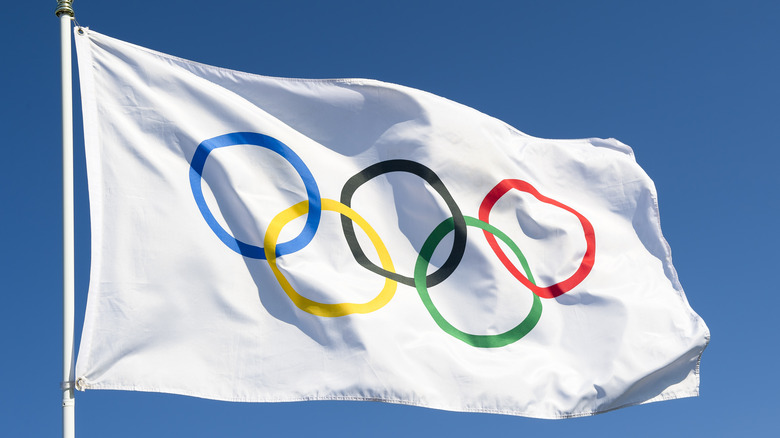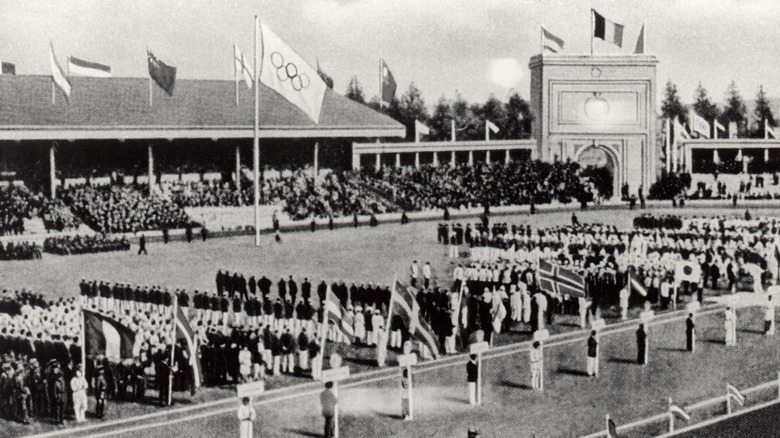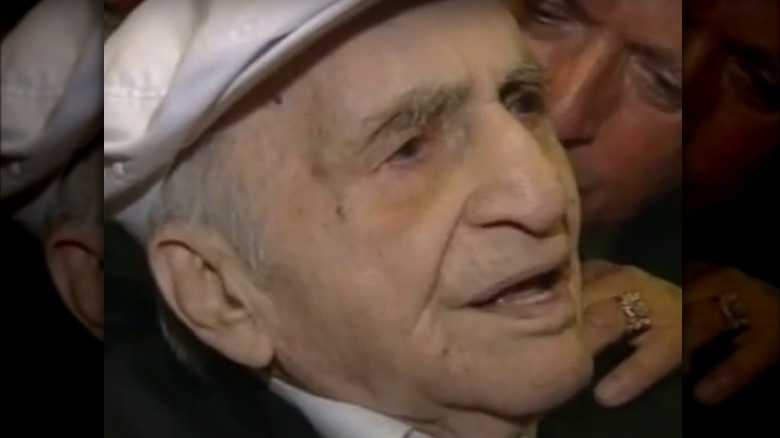The Real Reason The Original Olympics Flag Went Missing For 77 Years
Although the Olympic Games were revived in Greece in the late 19th century, the iconic five-ring flag did not appear until 1920. That year, the games were held in Belgium, in recognition of the losses the nation experienced during World War I (via the International Olympics Committee – IOC). Peace and international cooperation were top of mind after the devastation of Europe, so the opportunity was ripe to introduce the symbols designed by Pierre de Coubertin (one of the folks who resurrected the Olympics) several years earlier. The five rings represented North America, South America, Europe, Africa, and Asia, and were interlocked to symbolize unity.
King Albert I of Belgium declared the 1920 games open, and the first Olympic flag was marched into the stadium, with trumpets sounding and doves released into the sky. An athlete named Hal Haig "Harry" Prieste watched the proceedings. Prieste was a platform diver from California, who also worked as a Hollywood stuntman and actor (via IOC). He would leave the games with a bronze medal. But he stole an additional prize right off the flagpole.
It's in my suitcase
Teammate Duke Kahanamoku of Hawaii, who took home two gold medals in freestyle swimming, dared Hal Haig Prieste to steal the Olympic flag (via BBC). So Prieste snuck into the stadium at night before the end of the games, evaded the police, climbed up the 15-foot flagpole, and captured the flag. He successfully made it back to his room and hid the prize in his suitcase.
There it stayed for nearly 80 years, though Prieste, back in the United States, would show it to friends when the opportunity arose for a funny story (via We Are the Mighty). He doesn't seem to have thought much of the historical significance of the object, nor realized anyone was still talking about its mysterious disappearance decades later. In 1997, Prieste, at 100 years old, was enjoying a U.S. Olympic Committee banquet. He and a reporter were discussing the 1920 games. No one knows what happened to that first Olympic flag, the journalist said off-hand. "I can help you with that," Prieste replied. "It's in my suitcase" (via The New York Times).
The Oldest Flag and the Oldest Medalist
Hal Haig Prieste, after a long life of diving, stunts, films, skating in the Ice Follies, and even time in a circus, returned the historic flag to the International Olympic Committee at its well-publicized annual meeting in September 2000, according to ABC News. He was praised and thanked by the IOC president and a representative from Belgium, in addition to enjoying his moment in the media spotlight. "I'm proud to be part of the ceremony," he said. "When I give [the flag] away, it makes me feel good ... I ain't going to be around much longer." Not only was he celebrated for returning the artifact, but also because he was the oldest living Olympic medalist.
Prieste died about six months later, at 104 years old. This means the world came quite close to never seeing the flag again, had those handling Prieste's affairs and possessions not realized what he had. "You can't be selfish about these things," the prankster said before he died. "It's no good to me ... People will think more of me by giving it away than by keeping it" (via We Are the Mighty). The flag is now displayed at the Olympic Museum in Lausanne, Switzerland, with a plaque telling Prieste's story.


